CITROEN C1 2017 Owners Manual
Manufacturer: CITROEN, Model Year: 2017, Model line: C1, Model: CITROEN C1 2017Pages: 269, PDF Size: 7.63 MB
Page 151 of 269
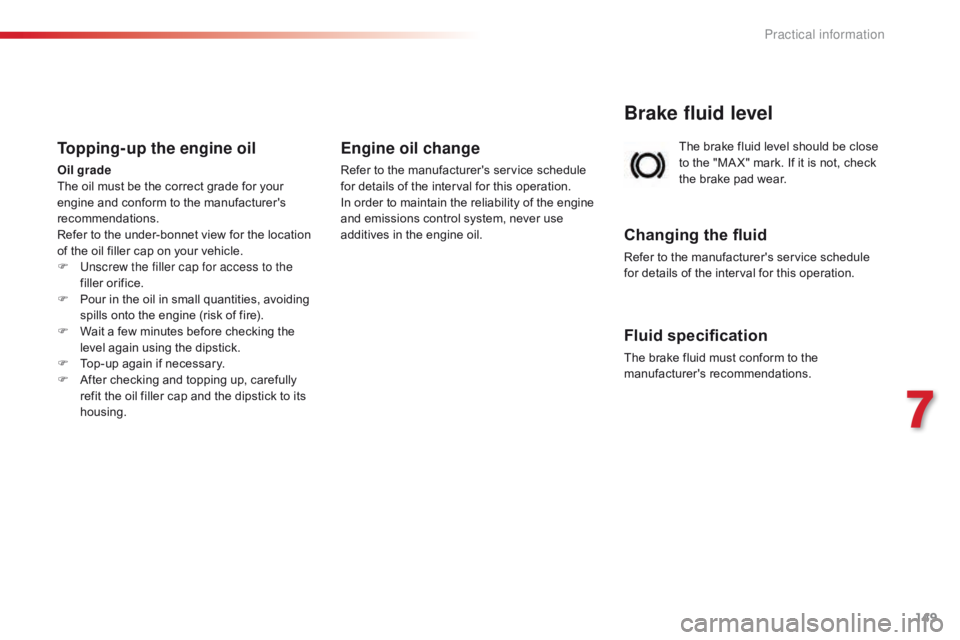
149
C1_en_Chap07_info-pratiques_ed01-2016
Theô brakeô fluidô levelô shouldô beô closeô to ô the ô "MA X" ô mark. ô If ô it ô is ô not, ô check ô
t
he ô brake ô pad ô wear.
Brake fluid level
Changing the fluid
Referô toô theô manufacturer'sô serviceô scheduleô for ô details ô of ô the ô interval ô for ô this ô operation.
Fluid specification
Theô brakeô fluidô mustô conformô toô theô manufacturer'sô r ecommendations.
Topping-up the engine oil
Oil grade
Theô oil ô must ô be ô the ô correct ô grade ô for ô your ô
e
ngine ô and ô conform ô to ô the ô manufacturer's ô
r
ecommendations.
Refer
ô to ô the ô under-bonnet ô view ô for ô the ô location ô
o
f ô the ô oil ô filler ô cap ô on ô your ô vehicle.
F
U
nscrew the filler cap for access to the
filler
ô orifice.
F
ô
P
our ô in ô the ô oil ô in ô small ô quantities, ô avoiding ô
s
pills ô onto ô the ô engine ô (risk ô of ô fire).
F
ô
W
ait ô a ô few ô minutes ô before ô checking ô the ô
l
evel ô again ô using ô the ô dipstick.
F
ô
T
op-up ô again ô if ô necessary.
F
ô
A
fter ô checking ô and ô topping ô up, ô carefully ô
r
efit ô the ô oil ô filler ô cap ô and ô the ô dipstick ô to ô its ô
h
ousing.
Engine oil change
Referô toô theô manufacturer'sô serviceô scheduleô for ô details ô of ô the ô interval ô for ô this ô operation.
In
ô order ô to ô maintain ô the ô reliability ô of ô the ô engine ô
a
nd ô emissions ô control ô system, ô never ô use ô
a
dditives ô in ô the ô engine ô oil.
7
Practical information
Page 152 of 269
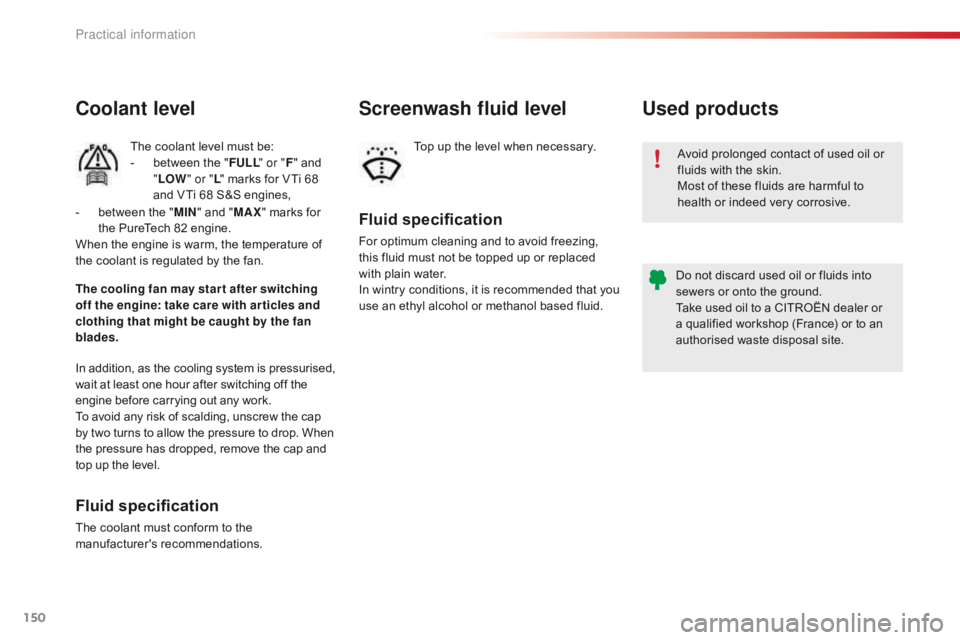
150
C1_en_Chap07_info-pratiques_ed01-2016
Avoidô prolongedô contactô ofô usedô oilô orô fluids ô with ô the ô skin.
Most
ô of ô these ô fluids ô are ô harmful ô to ô
h
ealth ô or ô indeed ô very ô corrosive.
Do
ô not ô discard ô used ô oil ô or ô fluids ô into ô
s
ewers ô or ô onto ô the ô ground.
Take
ô used ô oil ô to ô a ô CITROûN ô dealer ô or ô
a
ô qualified ô workshop ô (France) ô or ô to ô an ô
a
uthorised ô waste ô disposal ô site.
Used products
Fluid specification
Forô optimumô cleaningô andô toô avoidô freezing,ô this ô fluid ô must ô not ô be ô topped ô up ô or ô replaced ô
w
ith ô plain ô water.
In
ô
w
intry ô
c
onditions, ô
i
t ô
i
s ô
r
ecommended ô
t
hat ô
y
ou ô
u
se ô an ô ethyl ô alcohol ô or ô methanol ô based ô fluid.
Screenwash fluid level
Topô upô theô levelô whenô necessary.
Coolant level
Theô coolantô levelô mustô be:
- ô b etween ô the ô "FULL " or "F"
ô and ô
"LO
W" or " L"
ô marks ô for ô VTi ô 68 ô
a
nd ô VTi ô 68 ô S&S ô engines,
In
ô
addition, ô as ô the ô cooling ô system ô is ô pressurised,
ô w
ait
ô
at
ô
least ô one ô hour ô after ô switching ô off ô the
ô e
ngine
ô
before ô carrying ô out ô any ô work.
To
ô
avoid
ô
any ô risk ô of ô scalding, ô unscrew ô the ô cap
ô b
y
ô
two
ô
turns ô to ô allow ô the ô pressure ô to ô drop. ô When
ô t
he
ô
pressure ô has ô dropped, ô remove ô the ô cap ô and
ô t
op
ô
up
ô
the
ô level.
Fluid specification
Theô coolantô mustô conformô toô theô ma nufacturer'sô r ecommendations.
The cooling fan may star t after switching
off the engine: take care with ar ticles and
clothing that might be caught by the fan
blades. - ô
b
etween ô the ô "
MIN " ô and ô "
MAX " ô marks ô for ô
t
he ô PureTech ô 82 ô engine.
When ô the ô engine ô is ô warm, ô the ô temperature ô of ô
t
he ô coolant ô is ô regulated ô by ô the ô fan.
Practical information
Page 153 of 269
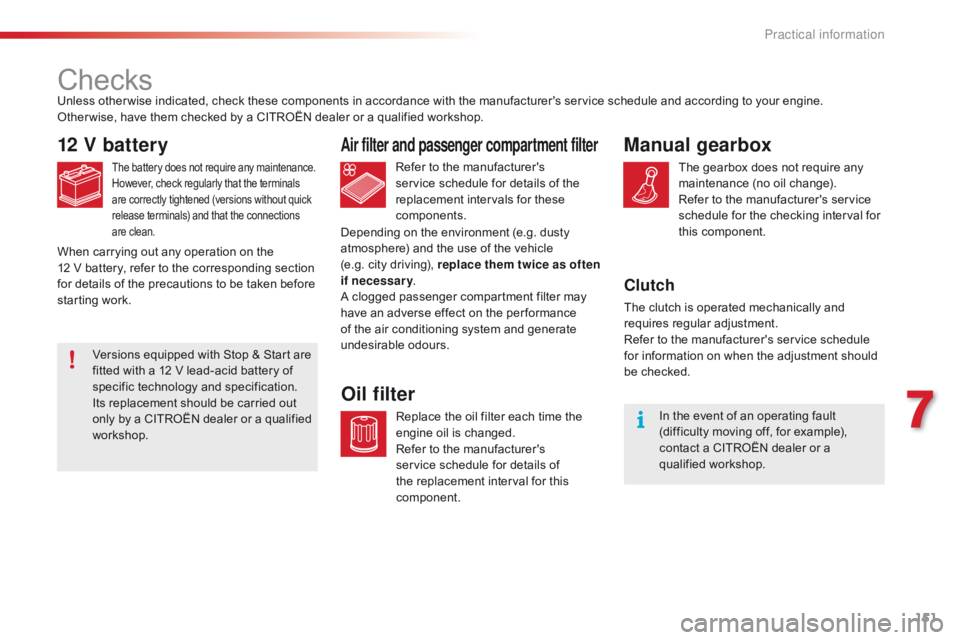
151
C1_en_Chap07_info-pratiques_ed01-2016
Checks
12 V battery
Theô batteryô doesô notô requireô anyô maintenance.
H owever, ô check ô regularly ô that ô the ô terminalsô a
re ô correctly ô tightened ô (versions ô without ô quick
ô r
elease ô terminals) ô and ô that ô the ô connections
ô a
re ô clean.Referô toô theô manufacturer'sô service ô schedule ô for ô details ô of ô the ô
r
eplacement ô intervals ô for ô these ô
c
omponents.
Air filter and passenger compartment filter
Replaceô theô oilô filterô eachô timeô theô e ngine ô oil ô is ô changed.
Refer
ô to ô the ô manufacturer's ô
s
ervice ô schedule ô for ô details ô of ô
t
he ô replacement ô interval ô for ô this ô
c
omponent.
Oil filter
Unlessô other wiseô indicated,ô checkô theseô componentsô inô accordanceô withô theô manufacturer'sô serviceô scheduleô andô accordingô toô yourô engine.
O ther wise, ô have ô them ô checked ô by ô a ô CITROûN ô dealer ô or ô a ô qualified ô workshop.
Depending
ô on ô the ô environment ô (e.g. ô dusty ô
a
tmosphere) ô and ô the ô use ô of ô the ô vehicle ô
(e.g.
ô city ô driving), ô replace them twice as often
if necessary .
A
ô clogged ô passenger ô compartment ô filter ô may ô
h
ave ô an ô adverse ô effect ô on ô the ô per formance ô
o
f ô the ô air ô conditioning ô system ô and ô generate ô
u
ndesirable
ô o
dours.
When
ô carrying ô out ô any ô operation ô on ô the ô
12
ô V ô battery, ô refer ô to ô the ô corresponding ô section ô
f
or ô details ô of ô the ô precautions ô to ô be ô taken ô before ô
s
tarting ô work.
Manual gearbox
Theô gearboxô doesô notô requireô anyô maintenance ô (no ô oil ô change).
Refer
ô to ô the ô manufacturer's ô service ô
s
chedule ô for ô the ô checking ô interval ô for ô
t
his
ô c
omponent.
Clutch
Theô clutchô isô operatedô mechanicallyô andô requiresô r egularô a djustment.
Refer
ô to ô the ô manufacturer's ô service ô schedule ô
f
or ô information ô on ô when ô the ô adjustment ô should ô
beô c
hecked.In
ô the ô event ô of ô an ô operating ô fault ô
(
difficulty ô moving ô off, ô for ô example), ô
c
ontact ô a ô CITROûN ô dealer ô or ô a ô
q
ualified
ô w
orkshop.
Versions
ô
equipped
ô
with
ô
Stop
ô
&
ô
Start
ô
are
ô
f
itted
ô
with
ô
a
ô
12
ô
V
ô
lead-acid
ô
battery
ô
of
ô
s
pecific
ô t
echnology
ô a
nd
ô s
pecification.
Its
ô
replacement
ô
should
ô
be
ô
carried
ô
out
ô
o
nly
ô
by
ô
a
ô
CITROûN
ô
dealer
ô
or
ô
a
ô
qualified
ô w
orkshop.
7
Practical information
Page 154 of 269
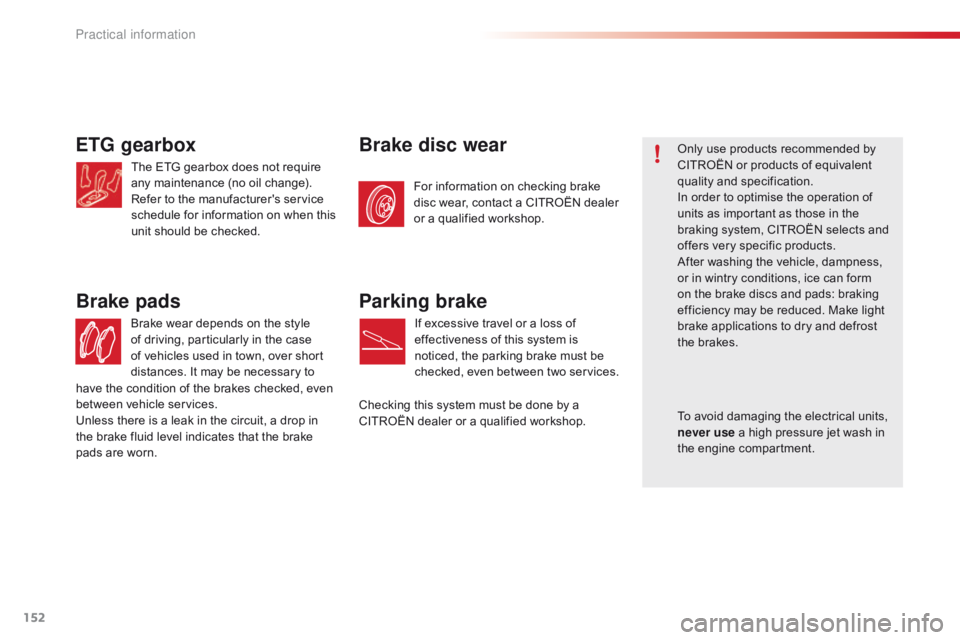
152
C1_en_Chap07_info-pratiques_ed01-2016
ETG gearbox
Theô ETGô gearboxô doesô notô requireô any ô maintenance ô (no ô oil ô change).
Refer
ô to ô the ô manufacturer's ô service ô
s
chedule ô for ô information ô on ô when ô this ô
u
nit ô should ô be ô checked.
Brake
ô wear ô depends ô on ô the ô style ô
o
f ô driving, ô particularly ô in ô the ô case ô
o
f ô vehicles ô used ô in ô town, ô over ô short ô
d
istances. ô It ô may ô be ô necessary ô to ô
Brake pads
Forô informationô onô checkingô brakeô disc ô wear, ô contact ô a ô CITROûN ô dealer ô
o
r ô a ô qualified ô workshop.
Brake disc wearOnlyô useô productsô recommendedô byô CITROûN ô or ô products ô of ô equivalent ô
q
uality
ô an
d
ô sp
ecification.
In
ô order ô to ô optimise ô the ô operation ô of ô
u
nits ô as ô important ô as ô those ô in ô the ô
b
raking ô system, ô CITROûN ô selects ô and ô
o
ffers ô very ô specific ô products.
After
ô washing ô the ô vehicle, ô dampness, ô
o
r ô in ô wintry ô conditions, ô ice ô can ô form ô
o
n ô the ô brake ô discs ô and ô pads: ô braking ô
e
fficiency ô may ô be ô reduced. ô Make ô light ô
b
rake ô applications ô to ô dry ô and ô defrost ô
t
he ô brakes.
Parking brake
Ifô excessiveô travelô orô aô lossô ofô effectiveness ô of ô this ô system ô is ô
n
oticed, ô the ô parking ô brake ô must ô be ô
c
hecked,
ô e
ven
ô b
etween
ô t
woô services.
Checking
ô
this ô system ô must ô be ô done ô by ô a ô
C
ITROûN
ô dealer ô or ô a ô qualified ô workshop.
have
ô
the
ô
condition
ô
of
ô
the
ô
brakes
ô
checked,
ô
even
ô
b
etween
ô v
ehicle
ô s
ervices.
Unless
ô
there
ô
is
ô
a
ô
leak
ô
in
ô
the
ô
circuit,
ô
a
ô
drop
ô
in
ô
t
he
ô
brake
ô
fluid
ô
level
ô
indicates
ô
that
ô
the
ô
brake
ô
p
ads
ô
are
ô
worn. To
ô avoid ô damaging ô the ô electrical ô units, ô
n
ever use ô a ô high ô pressure ô jet ô wash ô in ô
t
he ô engine ô compartment.
Practical information
Page 155 of 269
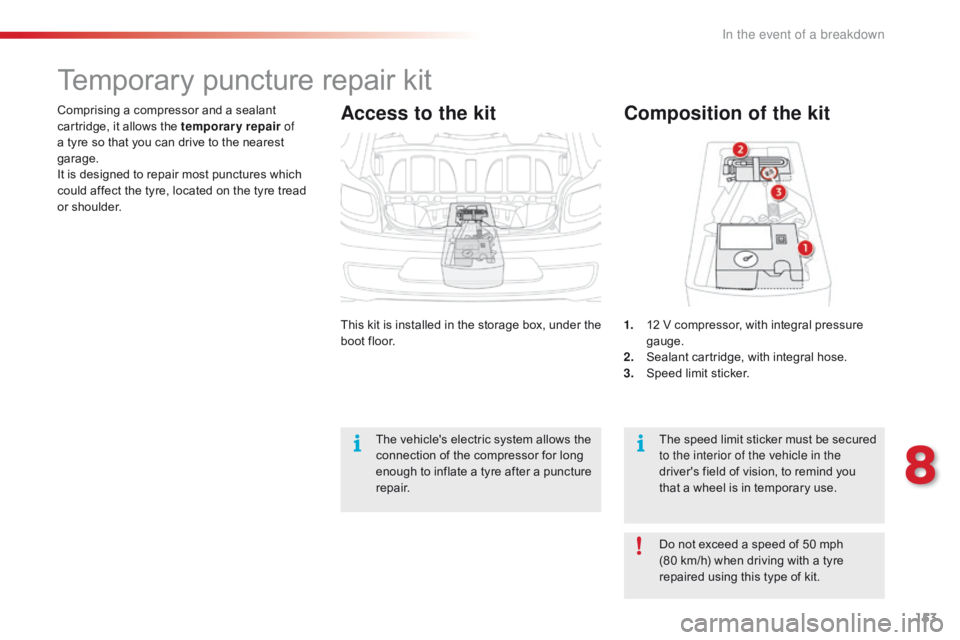
153
C1_en_Chap08_en-cas-pannes_ed01-2016
Comprisingô aô compressorô andô aô sealantô cartridge, ô it ô allows ô the ô temporary repair of
a
ô tyre ô so ô that ô you ô can ô drive ô to ô the ô nearest ô
g
arage.
It
ô is ô designed ô to ô repair ô most ô punctures ô which ô
c
ould ô affect ô the ô tyre, ô located ô on ô the ô tyre ô tread ô
o
r ô shoulder.
Temporaryô pu nctureô r epairô k it
Composition of the kit
1.ô 12ô V ô compressor, ô with ô integral ô pressure ô ga
uge.
2.
ô S
ealant ô cartridge, ô with ô integral ô hose.
3.
ô S
peed ô limit ô sticker.
The
ô speed ô limit ô sticker ô must ô be ô secured ô
t
o the interior of the vehicle in the
driver's
ô field ô of ô vision, ô to ô remind ô you ô
t
hat ô a ô wheel ô is ô in ô temporary ô use.
This
ô k
it
ô i
s
ô i
nstalled
ô i
n
ô t
he
ô s
torage
ô b
ox,
ô u
nder
ô t
he
ô b
oot
ô
floor.
The
ô
vehicle's
ô
electric
ô
system
ô
allows
ô
the
ô
c
onnection
ô
of
ô
the
ô
compressor
ô
for
ô
long
ô
e
nough
ô
to
ô
inflate
ô
a
ô
tyre
ô
after
ô
a
ô
puncture
ô
r
epair. Do
ô not ô exceed ô a ô speed ô of ô 50 ô mph ô
(
80ô km/h) ô when ô driving ô with ô a ô tyre ô
r
epaired ô using ô this ô type ô of ô kit.
Access to the kit
8
In the event of a breakdown
Page 156 of 269
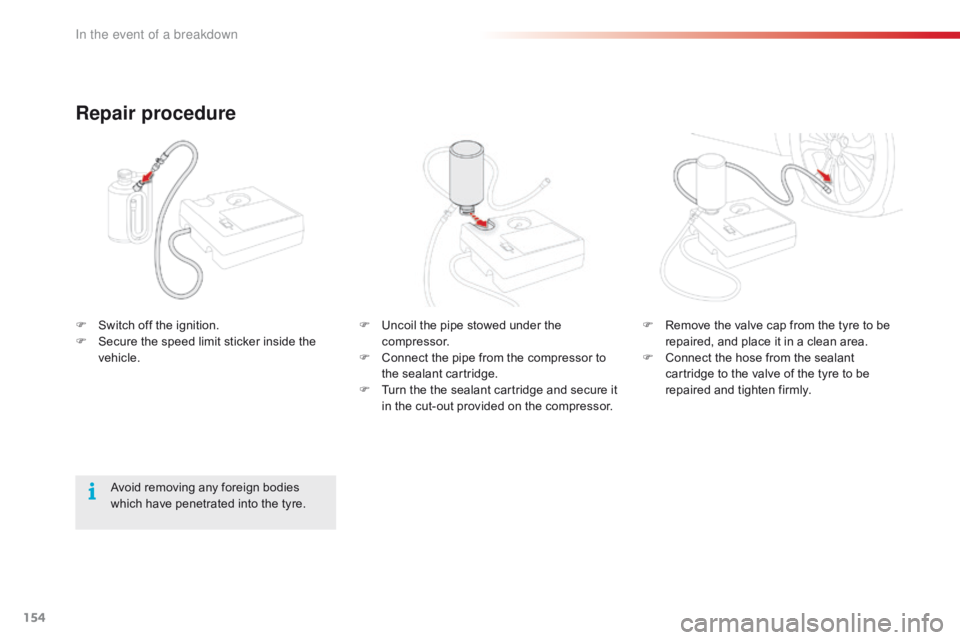
154
C1_en_Chap08_en-cas-pannes_ed01-2016
Fô Uncoilô the ô pipe ô stowed ô under ô the ô c
ompressor.
F
ô
C
onnect ô the ô pipe ô from ô the ô compressor ô to ô
t
he ô sealant ô cartridge.
F
ô
T
urn ô the ô the ô sealant ô cartridge ô and ô secure ô it ô
i
n ô the ô cut-out ô provided ô on ô the ô compressor.
Repair procedure
Avoidô removingô anyô foreignô bodiesô which ô have ô penetrated ô into ô the ô tyre. F
ô
R
emove ô the ô valve ô cap ô from ô the ô tyre ô to ô be ô
r
epaired, ô and ô place ô it ô in ô a ô clean ô area.
F ô
C
onnect ô the ô hose ô from ô the ô sealant ô
c
artridge ô to ô the ô valve ô of ô the ô tyre ô to ô be ô
r
epaired ô and ô tighten ô firmly.
F
ô
S
witch ô off ô the ô ignition.
F
ô
S
ecure ô the ô speed ô limit ô sticker ô inside ô the ô
v
ehicle.
In the event of a breakdown
Page 157 of 269
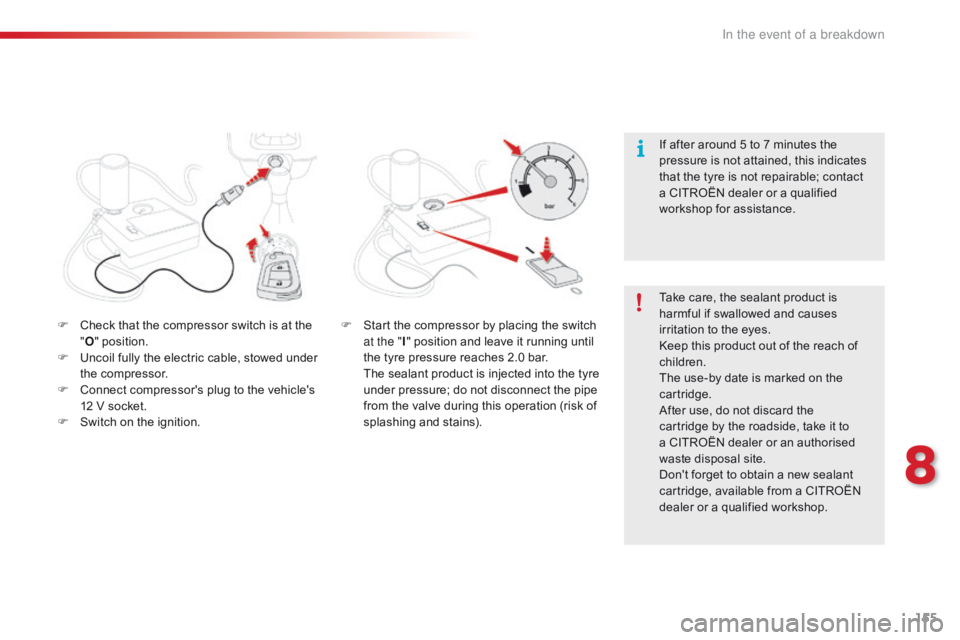
155
C1_en_Chap08_en-cas-pannes_ed01-2016
Fô Checkô that ô the ô compressor ô switch ô is ô at ô the ô "O "
ô position.
F
ô
U
ncoil ô fully ô the ô electric ô cable, ô stowed ô under ô
t
he ô compressor.
F
ô
C
onnect ô compressor's ô plug ô to ô the ô vehicle's ô
1
2 ô V ô socket.
F
ô
S
witch ô on ô the ô ignition. Take
ô care, ô the ô sealant ô product ô is ô h
armful ô if ô swallowed ô and ô causes ô i
rritation ô to ô the ô eyes.
Keep
ô this ô product ô out ô of ô the ô reach ô of ô
c
hildren.
The
ô use-by ô date ô is ô marked ô on ô the ô
c
artridge.
After
ô use, ô do ô not ô discard ô the ô
c
artridge ô by ô the ô roadside, ô take ô it ô to ô
a
ô CITROûNô dealer ô or ô an ô authorised ô
w
aste ô disposal ô site.
Don't
ô forget ô to ô obtain ô a ô new ô sealant ô
c
artridge, ô available ô from ô a ô CITROûN ô
d
ealer ô or ô a ô qualified ô workshop.
If
ô after ô around ô 5 ô to ô 7 ô minutes ô the ô
p
ressure ô is ô not ô attained, ô this ô indicates ô
t
hat ô the ô tyre ô is ô not ô repairable; ô contact ô
a
ô CITROûN ô dealer ô or ô a ô qualified ô
w
orkshop ô for ô assistance.
F ô S tart ô the ô compressor ô by ô placing ô the ô switch ô a
t the "I"
ô position ô and ô leave ô it ô running ô until ô
t
he ô tyre ô pressure ô reaches ô 2.0 ô bar.
ô T
he ô sealant ô product ô is ô injected ô into ô the ô tyre ô
u
nder ô pressure; ô do ô not ô disconnect ô the ô pipe ô
f
rom ô the ô valve ô during ô this ô operation ô (risk ô of ô
sp
lashing
ô an
d
ô s
tains).
8
In the event of a breakdown
Page 158 of 269
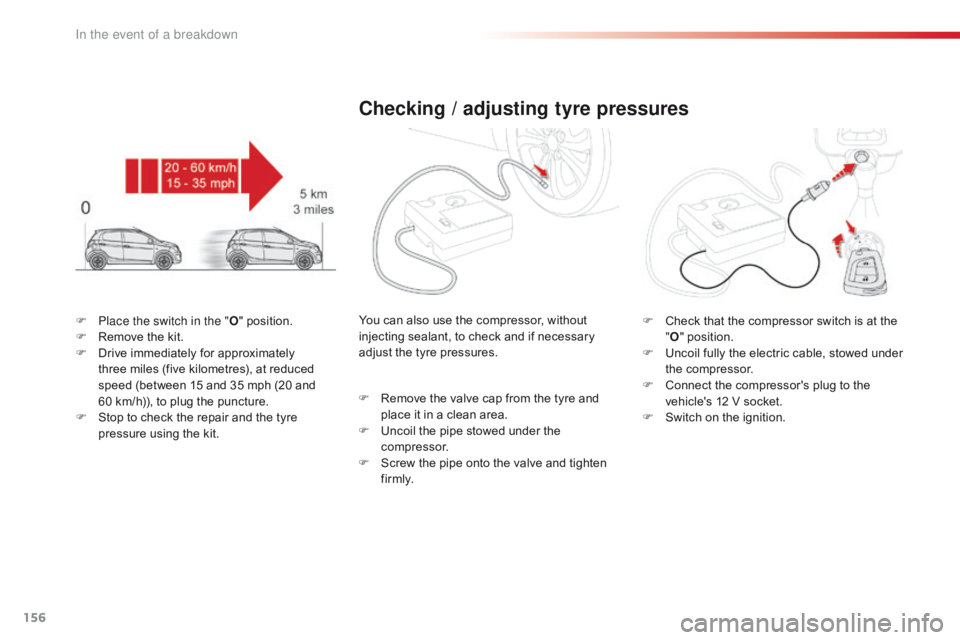
156
C1_en_Chap08_en-cas-pannes_ed01-2016
F Place the switch in the "O" ô position.
F ô R emove ô the ô kit.
F
ô
D
rive ô immediately ô for ô approximately ô
t
hree ô miles ô (five ô kilometres), ô at ô reduced ô
s
peed ô (between ô 15 ô and ô 35 ô mph ô (20 ô and ô
6
0ô km/h)), ô to ô plug ô the ô puncture.
F
ô
S
top ô to ô check ô the ô repair ô and ô the ô tyre ô
p
ressure ô using ô the ô kit.
Checking / adjusting tyre pressures
Fô Checkô that ô the ô compressor ô switch ô is ô at ô the ô "O "
ô position.
F
ô
U
ncoil ô fully ô the ô electric ô cable, ô stowed ô under ô
t
he ô compressor.
F
ô
C
onnect ô the ô compressor's ô plug ô to ô the ô
v
ehicle's ô 12 ô V ô socket.
F
ô
S
witch ô on ô the ô ignition.
You
ô
can
ô
also
ô
use
ô
the
ô
compressor,
ô
without
ô i
njecting
ô
sealant,
ô
to
ô
check
ô
and
ô
if
ô
necessary
ô
a
djust
ô
the
ô
tyre
ô
pressures.
F
ô
R
emove
ô
the
ô
valve
ô
cap
ô
from
ô
the
ô
tyre
ô
and
ô
p
lace
ô
it
ô
in
ô
a
ô
clean
ô
area.
F
ô
U
ncoil
ô
the
ô
pipe
ô
stowed
ô
under
ô
the
ô
c
ompressor.
F
ô
S
crew
ô
the
ô
pipe
ô
onto
ô
the
ô
valve
ô
and
ô
tighten
ô
f
i r m l y.
In the event of a breakdown
Page 159 of 269
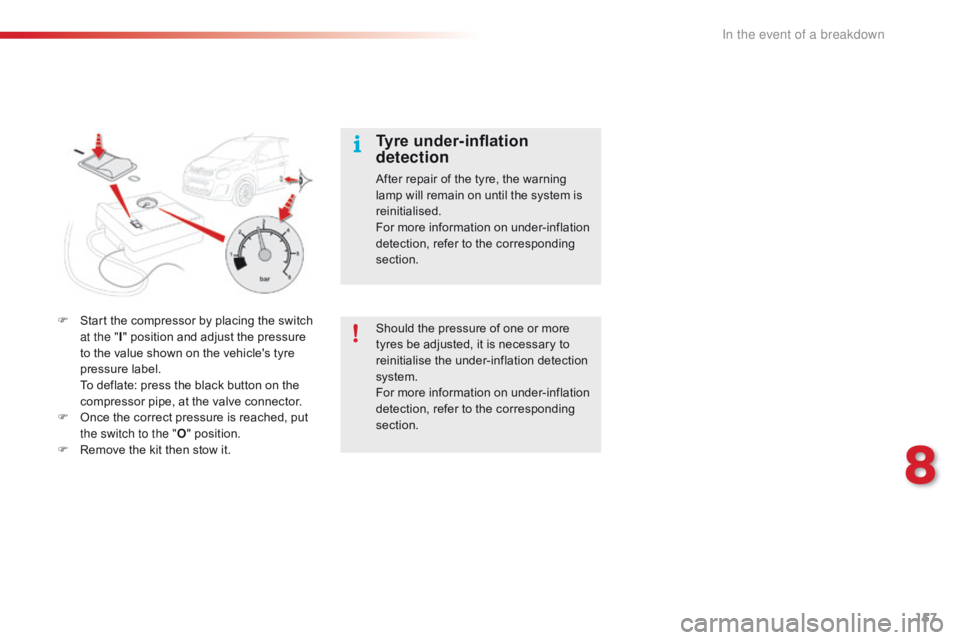
157
C1_en_Chap08_en-cas-pannes_ed01-2016
Shouldô theô pressureô ofô oneô orô moreô tyres ô be ô adjusted, ô it ô is ô necessary ô to ô
r
einitialise ô the ô under-inflation ô detection ô
s
ystem.
For
ô more ô information ô on ô under-inflation ô
d
etection, ô refer ô to ô the ô corresponding ô
s
ection.
Tyre under-inflation
detection
Afterô repairô ofô theô tyre,ô theô warningô lamp ô will ô remain ô on ô until ô the ô system ô is ô
r
einitialised.
For
ô more ô information ô on ô under-inflation ô
d
etection, ô refer ô to ô the ô corresponding ô
s
ection.
F
ô
S
tart
ô
the
ô
compressor
ô
by
ô
placing
ô
the
ô
switch
ô
a
t the " I"
ô
position
ô
and
ô
adjust
ô
the
ô
pressure
ô
t
o
ô
the
ô
value
ô
shown
ô
on
ô
the
ô
vehicle's
ô
tyre
ô
p
ressure
ô
label.
ô T
o
ô
deflate:
ô
press
ô
the
ô
black
ô
button
ô
on
ô
the
ô
c
ompressor
ô
pipe,
ô
at
ô
the
ô
valve
ô
connector.
F
ô
O
nce
ô
the
ô
correct
ô
pressure
ô
is
ô
reached,
ô
put
ô
t
he switch to the " O"
ô
position.
F
ô
R
emove
ô
the
ô
kit
ô
then
ô
stow
ô
it.
8
In the event of a breakdown
Page 160 of 269
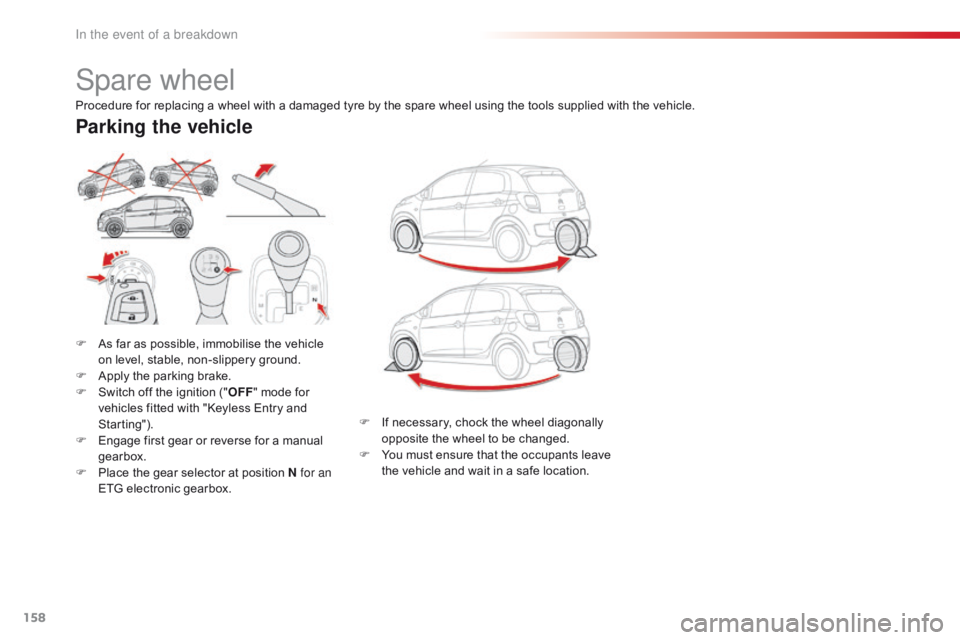
158
C1_en_Chap08_en-cas-pannes_ed01-2016
Spare wheel
Fô Asô far ô as ô possible, ô immobilise ô the ô vehicle ô o
n ô level, ô stable, ô non-slippery ô ground.
F
ô
A
pply ô the ô parking ô brake.
F
ô
S
witch ô off ô the ô ignition ô ("OFF "
ô mode ô for ô
v
ehicles ô fitted ô with ô "Keyless ô Entry ô and ô
S
tarting").
F
ô
E
ngage ô first ô gear ô or ô reverse ô for ô a ô manual ô
g
earbox.
F
ô
P
lace ô the ô gear ô selector ô at ô position ô N for an
ETG
ô electronic ô gearbox.
Parking the vehicle
Procedureô forô replacingô aô wheelô withô aô damagedô tyreô byô theô spareô wheelô usingô theô toolsô suppliedô withô theô vehicle.
F ô
I
f ô necessary, ô chock ô the ô wheel ô diagonally ô
o
pposite ô the ô wheel ô to ô be ô changed.
F
ô
Y
ou ô must ô ensure ô that ô the ô occupants ô leave ô
t
he ô vehicle ô and ô wait ô in ô a ô safe ô location.
In the event of a breakdown